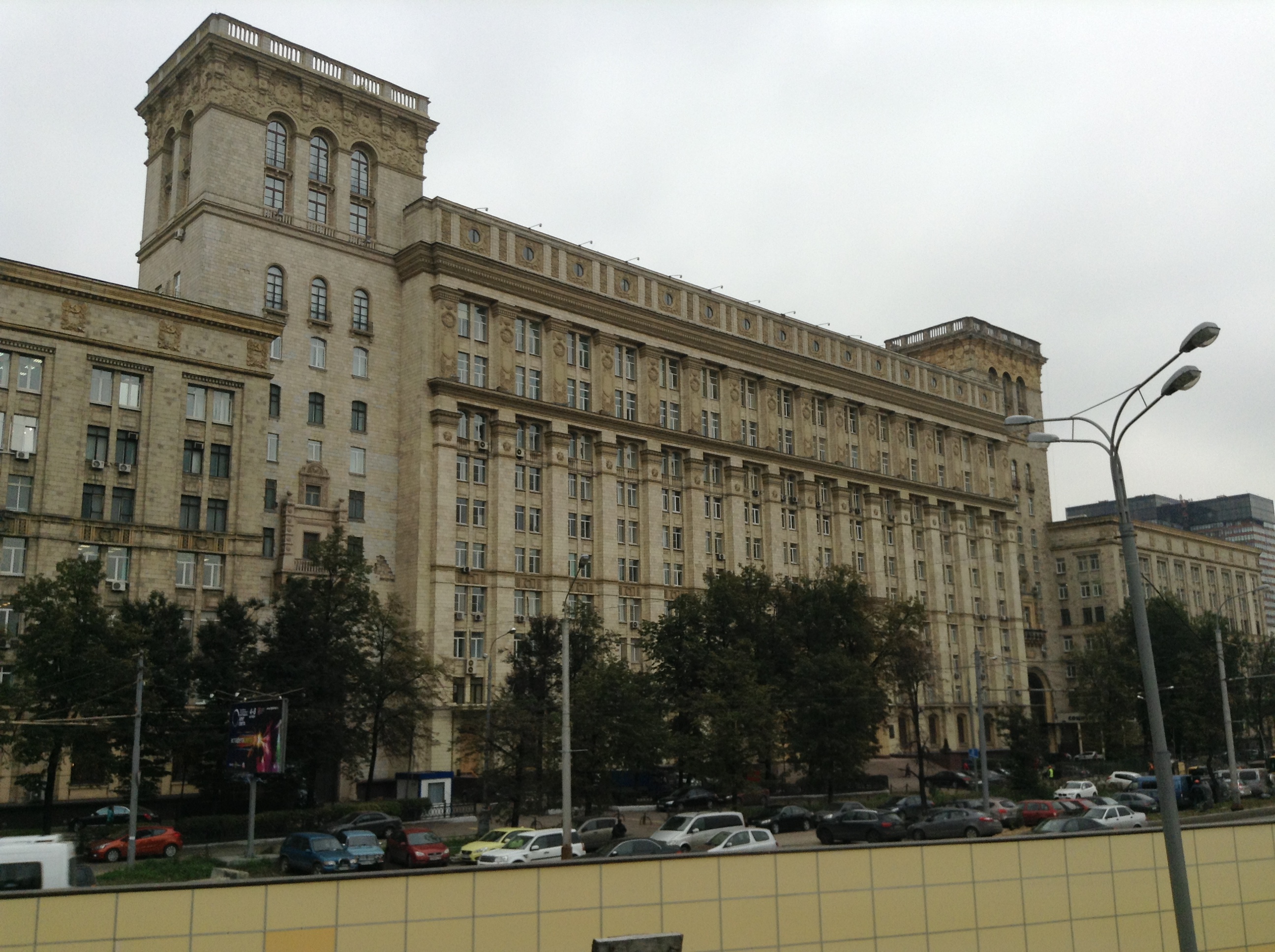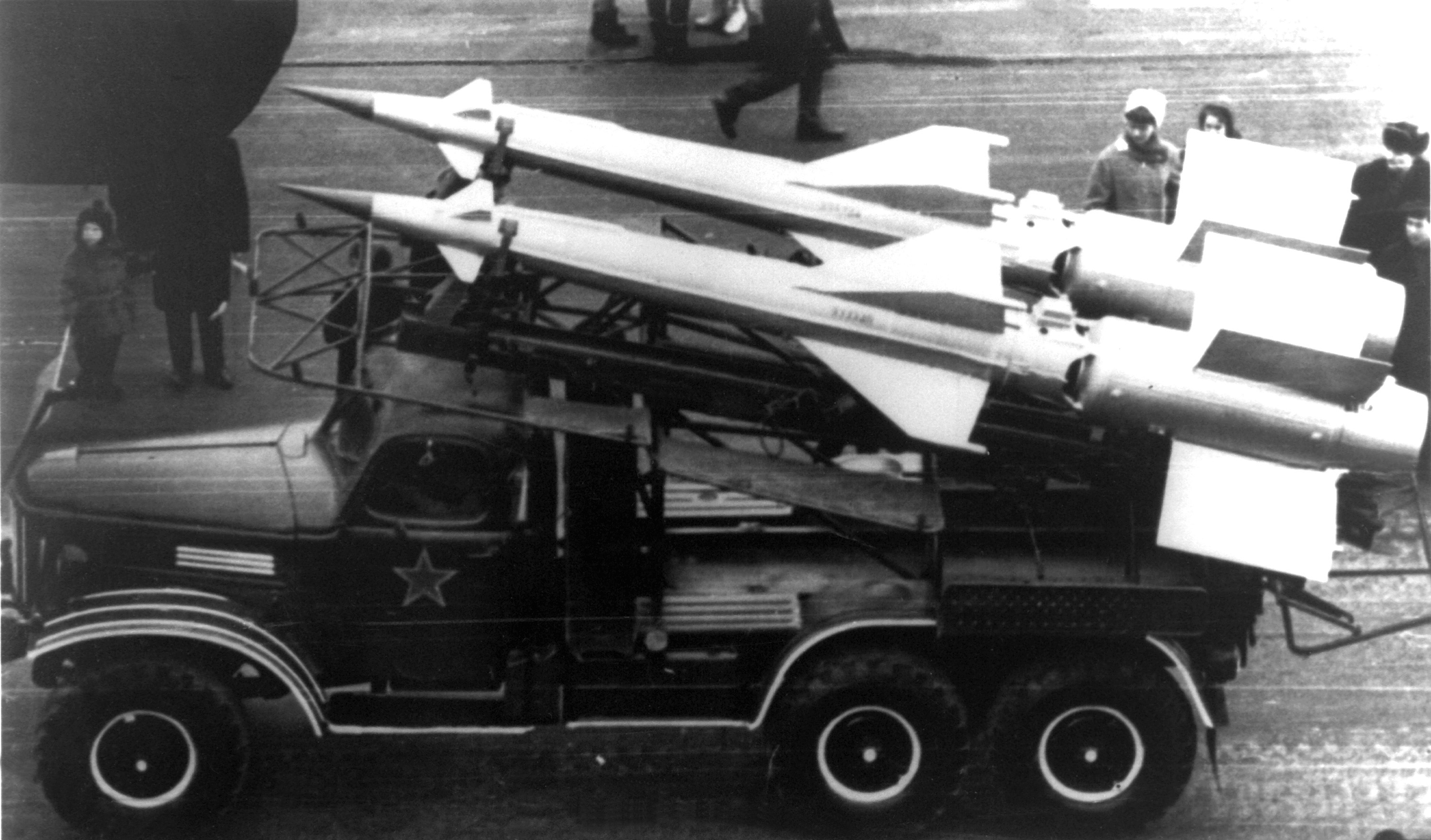|
Almaz Scientific Industrial Corporation
JSC NPO Almaz named after A.A. Raspletin (, former SB-1, 1947–1950; KB-1, 1950–1966; MKB Strela, 1966–1971; TsKB Almaz, 1971–1988; NPO Almaz, 1988–2008; GSKB Almaz-Antey, 2008–2015) is a Soviet/Russian military R&D enterprise founded in 1947. It is the core of the Almaz-Antey holding. Headquarters – Moscow, Leningradsky av., 80. History The company is named after its chief designer . Since 1955, KB-1 developed such air defence missile systems as the S-25 Berkut, S-75 Dvina, S-125 Neva/Pechora, S-200 Angara/Vega/Dubna, S-300, S-400 Triumf, S-300PMU, S-300PMU2, and S-350E Vityaz. On 30 November 2009, the board of directors of Almaz-Antey voted to reorganize the joint-stock companies NIEMI, NIIRP, MNIIRE Altair and MNIIPA, merging them with NPO Almaz to form GSKB joint venture. GSKB became the head R&D arm of Almaz-Antey holdings, becoming its Head System Design Bureau (). NIIRP scientific & research center is developing the Joint system of air and ba ... [...More Info...] [...Related Items...] OR: [Wikipedia] [Google] [Baidu] |
Joint Stock Company
A joint-stock company (JSC) is a business entity in which shares of the company's capital stock, stock can be bought and sold by shareholders. Each shareholder owns company stock in proportion, evidenced by their share (finance), shares (certificates of ownership). Shareholders are able to transfer their shares to others without any effects to the Perpetual succession, continued existence of the company. In modern-day corporate law, the existence of a joint-stock company is often synonymous with incorporation (business), incorporation (possession of legal personality separate from shareholders) and limited liability (shareholders are liable for the company's debts only to the value of the money they have invested in the company). Therefore, joint-stock companies are commonly known as corporations or limited company, limited companies. Some jurisdiction (area), jurisdictions still provide the possibility of registering joint-stock companies without limited liability. In the Unite ... [...More Info...] [...Related Items...] OR: [Wikipedia] [Google] [Baidu] |
S-125 Neva/Pechora
The S-125 ''Neva/Pechora'' (, NATO reporting name SA-3 ''Goa'') is a Soviet surface-to-air missile system that was designed by Aleksei Isaev to complement the S-25 Berkut, S-25 and S-75 Dvina, S-75. It has a shorter effective range and lower engagement altitude than either of its predecessors and also flies slower, but due to its two-stage design it is more effective against more maneuverable targets. It is also able to engage lower flying targets than the previous systems, and being more modern it is much more resistant to electronic countermeasures, ECM than the S-75. The 5V24 (V-600) missiles reach around Mach number, Mach 3 to 3.5 in flight, both stages powered by Rocket propellant#Solid chemical propellants, solid fuel rocket motors. The S-125, like the S-75 Dvina, S-75, uses radio command guidance. The naval version of this system has the NATO reporting name SA-N-1 Goa and original designation M-1 Volna (Russian Волна – ''wave''). Operational history Soviet Union Th ... [...More Info...] [...Related Items...] OR: [Wikipedia] [Google] [Baidu] |
S-300V
The S-300 (NATO reporting name SA-10 Grumble) is a series of long-range surface-to-air missile systems developed by the former Soviet Union. It was produced by NPO Almaz for the Soviet Air Defence Forces to defend against air raids and cruise missiles. It is used by Russia, Ukraine, and other former Eastern Bloc countries, along with Bulgaria and Greece. It is also used by China, Iran, and other countries in Asia. The system is fully automated, though manual observation and operation are also possible. Each targeting radar provides target designation for the central command post. The command post compares the data received from the targeting radars and filters out false targets. The central command post has both active and passive target detection modes. Missiles have a maximum range of from the command post. The successor to the S-300 is the S-400 (NATO reporting name ''SA-21 Growler''), which entered service on 28 April 2007. Variations and upgrades There are currentl ... [...More Info...] [...Related Items...] OR: [Wikipedia] [Google] [Baidu] |
Antey-2500
The S-300VM "Antey-2500" (, NATO reporting name SA-23 Gladiator/Giant) is a Russian anti-ballistic missile system. The system is designed to target short- and medium-range ballistic missiles, aeroballistic missiles, cruise missiles, fixed-wing aircraft, loitering ECM platforms, and precision-guided munitions. Structure Components The Antey-2500 air defense missile system features: * Battle performance automation due to high-speed digital computers * Passive electronically scanned array radars with advanced data processing methods * High ECM immunity * High mobility and autonomous operation * High firepower potential, irrespective of air attack tactics or sequence * Vertical launch from a special transport launch canister * Maintenance-free operation of missiles for at least ten years * Capability to defeat ballistic missile individual warheads * Inertial guidance with radio command mid-course update and semi-active radar homing at the terminal phase * Focused detonation of ... [...More Info...] [...Related Items...] OR: [Wikipedia] [Google] [Baidu] |
S-300P
The S-300 (NATO reporting name SA-10 Grumble) is a series of long-range surface-to-air missile systems developed by the former Soviet Union. It was produced by NPO Almaz for the Soviet Air Defence Forces to defend against air raids and cruise missiles. It is used by Russia, Ukraine, and other former Eastern Bloc countries, along with Bulgaria and Greece. It is also used by China, Iran, and other countries in Asia. The system is fully automated, though manual observation and operation are also possible. Each targeting radar provides target designation for the central command post. The command post compares the data received from the targeting radars and filters out false targets. The central command post has both active and passive target detection modes. Missiles have a maximum range of from the command post. The successor to the S-300 is the S-400 (NATO reporting name ''SA-21 Growler''), which entered service on 28 April 2007. Variations and upgrades There are current ... [...More Info...] [...Related Items...] OR: [Wikipedia] [Google] [Baidu] |
S-500 (missile)
The S-500 Prometheus (), also known as 55R6M "Triumfator-M", is a Russian surface-to-air missile/anti-ballistic missile system supplementing the S-400 and the A-235 ABM missile system. The S-500 was developed by the Almaz-Antey Air Defence Concern. Initially planned to be in production by 2014, the first unit entered service in 2021 with the 15th Aerospace Army. Russia claims that the S-500 is capable of intercepting all types of modern hypersonic weapons, and has claimed to have successfully tested such capability. Russia is reportedly planning to deploy the S-500 alongside the planned S-550 missile system as part of its air defense network. History According to the original plans, ten S-500 battalions were to be purchased for the Russian Aerospace Defense (VKO) under the State Armament Programme 2020 (GPV-2020). As of 2013, the S-500s were intended to work in parallel with S-400s, and the systems together were planned to replace most of the S-300 missile systems. The first ... [...More Info...] [...Related Items...] OR: [Wikipedia] [Google] [Baidu] |
A-35 Anti-ballistic Missile System
The A-35 anti-ballistic missile system was a USSR, Soviet military anti-ballistic missile (ABM) system deployed around Moscow to intercept enemy ballistic missiles targeting the city or its surrounding areas. The A-35 was the only Soviet ABM system allowed under the 1972 Anti-Ballistic Missile Treaty. In development as of the 1960s and in operation from June 1972 until the 1990s, it featured the nuclear-armed ABM-1 Galosh, A350 Exosphere, exoatmospheric interceptor missile. The A-35 was supported by two Dunay radars (NATO reporting name, NATO reporting names: Cat House and Dog House) and the Soviet early warning system. It was followed by the A-135 anti-ballistic missile system, A-135 in the early 1990s. System A The first Soviet anti-ballistic missile system was System A, which began development at Sary Shagan, Sary Shagan's Test Range A in July 1956, followed by testing starting in 1959. System A used the Fakel V-1000, V-1000 missile to intercept enemy missiles. First launch of t ... [...More Info...] [...Related Items...] OR: [Wikipedia] [Google] [Baidu] |
A-135 Anti-ballistic Missile System
The A-135 (NATO reporting name, NATO: ABM-4 Gorgon) is a Russian anti-ballistic missile system deployed around Moscow to intercept incoming warheads targeting the city or its surrounding areas. The system was designed in the Soviet Union and entered service in 1995. It is a successor to the previous A-35 anti-ballistic missile system, A-35, and complies with the 1972 Anti-Ballistic Missile Treaty. The system is operated by the 9th Division of Anti-Missile Defence, part of the Air Defence and Missile Defence Command of the Russian Aerospace Defence Forces. History A memo from the archives of Vitalii Kataev, written around 1985, had envisaged that the system "will be completed in 1987 to provide protection from a strike of 1–2 modern and prospective ICBMs and up to 35 Pershing 2-type intermediate-range missiles". The A-135 system attained "alert" (operational) status on February 17, 1995. It is operational although its 51T6 component was deactivated in February 2007. A newer miss ... [...More Info...] [...Related Items...] OR: [Wikipedia] [Google] [Baidu] |
Design Bureau
OKB () is a transliteration of the Russian initials for "" (), which translates to "Experimental Design Bureau." It could also mean or "Special Design Bureau" in english. During the Soviet era, OKBs were closed institutions working on design and prototyping of advanced technology, usually for military applications. The corresponding English language term for such a bureau's activity is R&D or "research and development." For security, each bureau was only officially identified by a number, but were often semi-officially referenced by the name of its lead designer. For example, OKB-51 was led by Pavel Sukhoi, and it eventually became known as simply Sukhoi. Successful and famous bureaus often retained these names after the departure of their founding designer. These relatively small state-run organisations were not intended for mass production of aircraft, rockets, or other vehicles or equipment which they designed. However, they usually had the facilities and resources to cons ... [...More Info...] [...Related Items...] OR: [Wikipedia] [Google] [Baidu] |
Vityaz Missile System
The S-350 Vityaz () is a Russian medium-range surface-to-air missile system developed by GSKB Almaz-Antey. Its purpose is to replace the S-300PS. The system design traces its roots from the joint South Korean-Russian KM-SAM project and uses the same 9M96 missile as the S-400 missile system. Development The first studies that would eventually become the S-350 started in 1999. Development began in earnest only in 2007. Almaz-Antey was able to leverage the experience gained while working on the joint development of the KM-SAM with South Korea. Around 2011, development slowed down, probably due to failed missile tests. The S-350 was unveiled in 2013, and presented at that year's MAKS airshow. Initial plans called for the system's test phase to end in the autumn of 2013, and for the delivery of around 30 systems by 2020. However, the first deliveries of the S-350 only took place in 2019, and it only entered service in February 2020. Design The S-350 ''Vityaz'' air defense system cons ... [...More Info...] [...Related Items...] OR: [Wikipedia] [Google] [Baidu] |
S-300PMU
The S-300 (NATO reporting name SA-10 Grumble) is a series of long-range surface-to-air missile systems developed by the former Soviet Union. It was produced by NPO Almaz for the Soviet Air Defence Forces to defend against air raids and cruise missiles. It is used by Russia, Ukraine, and other former Eastern Bloc countries, along with Bulgaria and Greece. It is also used by China, Iran, and other countries in Asia. The system is fully automated, though manual observation and operation are also possible. Each targeting radar provides target designation for the central command post. The command post compares the data received from the targeting radars and filters out false targets. The central command post has both active and passive target detection modes. Missiles have a maximum range of from the command post. The successor to the S-300 is the S-400 (NATO reporting name ''SA-21 Growler''), which entered service on 28 April 2007. Variations and upgrades There are current ... [...More Info...] [...Related Items...] OR: [Wikipedia] [Google] [Baidu] |






